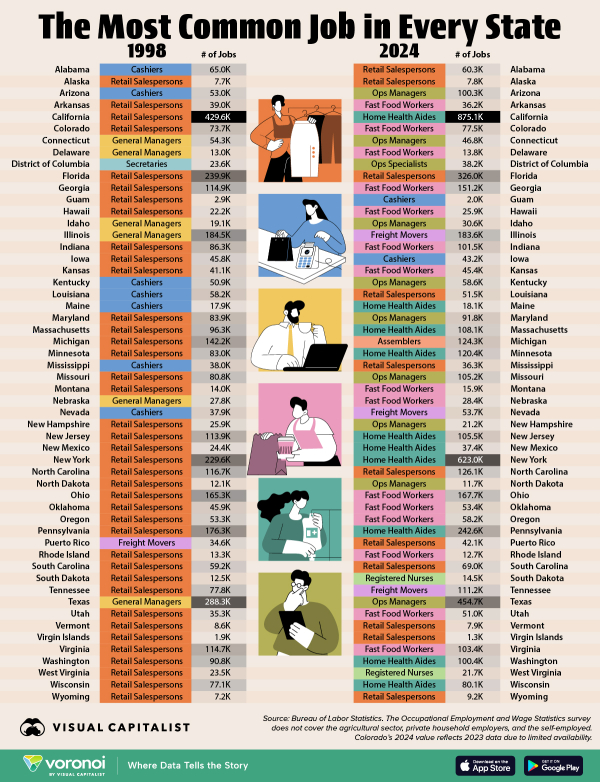1998 was a long time ago. My oldest son was just a twinkle in my eye. Michael Jackson was touring the world for his ‘Bad’ album, and ‘Rain Man’ topped the movie charts. It’s also the year that Microsoft Office was released.
A lot has changed since then. For obvious reasons, the U.S. labor market has changed radically since then ... but how different is it really?
 via visualcapitalist
via visualcapitalist
The data comes from the Bureau of Labor Statistics, so we can assume it’s relatively accurate.
In 1988, consumer-facing roles, such as salespeople and cashiers, were the most common jobs in 46 states. Comparing that to 2024 highlights how much less reliance we have on brick-and-mortar stores.
While not entirely different, now fast food workers are the most common job in 15 states. This is unsurprising in light of the shift toward lower-wage & flexible-hour service jobs. Meanwhile, retail salespersons are still the top job in 11 states.
Operations managers, home health aides, and freight movers have made significant gains in the U.S. labor market.
I was surprised to see how many home health aides there were, but considering the aging U.S. population, it makes sense.
The U.S. is still clearly a consumer economy; however, the focus has switched towards logistics and supply chain, as people shop increasingly online.
I’ve been thinking a lot about the future of work. People talk about change, but so far, things have felt relatively stable. That’s about to shift. AI is advancing faster than most realize—we’re still early on the curve, but the steep climb is beginning.
We’re entering a phase where AI is no longer just a tool—it’s becoming a collaborator in both our personal and professional lives. This shift will reshape how we work, create, and make decisions. For business leaders, that means looking past the hype and focusing on real value, workforce readiness, and building trust. For employees, it means adapting to a new kind of teamwork—one that includes AI as a core partner in creativity and productivity.
How will those changes show up in a chart like this?
We live in interesting times!
How Has The Job Market Changed Since 1988?
1998 was a long time ago. My oldest son was just a twinkle in my eye. Michael Jackson was touring the world for his ‘Bad’ album, and ‘Rain Man’ topped the movie charts. It’s also the year that Microsoft Office was released.
A lot has changed since then. For obvious reasons, the U.S. labor market has changed radically since then ... but how different is it really?
The data comes from the Bureau of Labor Statistics, so we can assume it’s relatively accurate.
In 1988, consumer-facing roles, such as salespeople and cashiers, were the most common jobs in 46 states. Comparing that to 2024 highlights how much less reliance we have on brick-and-mortar stores.
While not entirely different, now fast food workers are the most common job in 15 states. This is unsurprising in light of the shift toward lower-wage & flexible-hour service jobs. Meanwhile, retail salespersons are still the top job in 11 states.
Operations managers, home health aides, and freight movers have made significant gains in the U.S. labor market.
I was surprised to see how many home health aides there were, but considering the aging U.S. population, it makes sense.
The U.S. is still clearly a consumer economy; however, the focus has switched towards logistics and supply chain, as people shop increasingly online.
I’ve been thinking a lot about the future of work. People talk about change, but so far, things have felt relatively stable. That’s about to shift. AI is advancing faster than most realize—we’re still early on the curve, but the steep climb is beginning.
We’re entering a phase where AI is no longer just a tool—it’s becoming a collaborator in both our personal and professional lives. This shift will reshape how we work, create, and make decisions. For business leaders, that means looking past the hype and focusing on real value, workforce readiness, and building trust. For employees, it means adapting to a new kind of teamwork—one that includes AI as a core partner in creativity and productivity.
Posted at 06:39 PM in Business, Current Affairs, Food and Drink, Gadgets, Healthy Lifestyle, Ideas, Market Commentary, Personal Development, Science, Trading, Web/Tech | Permalink
Reblog (0)